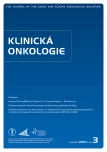Current Possibilities of Early Detection of Cardiotoxicity of Cytostatic Treatment
Authors:
Katarína Balážová 1; Daniela Kubincová 2
Authors‘ workplace:
Oddelenie všeobecnej kardiológie, Stredoslovenský ústav srdcových a cievnych chorôb a. s., Banská Bystrica, Slovenská republika
1; Hematologické oddelenie, Fakultná nemocnica s poliklinikou F. D. Roosevelta, Banská Bystrica, Slovenská republika
2
Published in:
Klin Onkol 2020; 33(3): 208-213
Category:
Original Articles
doi:
https://doi.org/10.14735/amko2020208
Overview
Background: Due to growing long-term survival rate of oncologic patients, there is increased interest in cardiotoxicity of oncologic treatment among medical professionals. It is concerning both paediatric and adult patients. When prescribing oncologic treatment, there should be focus on the efficacy and safety of the used drugs. Nowadays, the main problem is early diagnosis of cardiotoxicity.
Purpose: In our work we wanted to investigate whether the increase in biomarkers after the cytostatic therapy with anthracyclines can predict further increase in the left ventricular volume and decrease of the left ventricular ejection fraction.
Materials and methods: We were monitoring 36 patients with the diagnosis of non-Hodgkin’s lymphoma who received therapy with anthracyclines. After the therapy we were measuring the cardiac biomarkers NT-proBNP and high-sensitivity troponin I and performed echocardiography.
Results: In our group of patients there is a statistically significant correlation between increased levels of troponin I, NT-proBNP and increment of the left ventricular volume measured before the treatment and 3 months after the treatment. There is also a significant inverse correlation between the left ventricular volume and left ventricular ejection fraction. There was no relationship between higher cumulative doses of anthracyclines and the increment of the left ventricular volume. There is a significant correlation between higher cumulative doses of anthracyclines and higher levels of troponin I.
Conclusion: The measurement of biomarkers troponin I and NT-proBNP should be considered for an early diagnosis of cardiotoxicity in oncologic patients. Echocardiography is also beneficial for the diagnosis in these patients. All efforts after the diagnosis should be focused on the therapy with cardioprotective drugs, which can prevent the development of severe heart failure.
Keywords:
Chemotherapy – cardiotoxicity – anthracyclines – cardiomyopathy – heart failure – oncologic treatment
Sources
1. Zamorano JL, Lancellotti P, Rodriguez Muñoz D et al. 2016 ESC position paper on cancer treatments and cardiovascular toxicity developed under the auspices of the ESC Committee for Practice Guidelines: The task force for cancer treatments and cardiovascular toxicity of the European Society of Cardiology (ESC). Eur Heart J 2016; 37 (36): 2768–2801. doi: 10.1093/eurheartj/ehw211.
2. Mladosievičová B et al. Kardioonkológia. Bratislava: SAP 2012.
3. Eichenauer DA, Engert A, André M et al. Hodgkin’s lymphoma: ESMO Clinical Practice Guidelines for diagnosis, treatment and follow-up. Ann Oncol 2014; 25 (Suppl 3): 70–75. doi: 10.1093/annonc/mdu181.
4. Herrmann J, Lerman A, Sandhu NP et al. Evaluation and management of patients with heart disease and cancer: cardio-oncology. Mayo Clin Proc 2014; 89 (9): 1287–1306. doi: 10.1016/j.mayocp.2014.05.013.
5. Yeh JM, Nohria A, Diller L. Routine echocardiography screening for asymptomatic left ventricular dysfunction in childhood cancer survivors: a model-based estimation of the clinical and economic effects. Ann Intern Med 2014; 160 (10): 661–671. doi: 10.7326/M13-2266.
6. Cardinale D, Sandri MT, Martinoni A. Myocardial injury revealed by plasma troponin I in breast cancer treated with high-dose chemotherapy. Ann Oncol 2002; 13 (5): 710–715. doi: 10.1093/annonc/mdf170.
7. Cardinale D, Sandri MT, Colombo A et al. Prognostic value of troponin I in cardiac risk stratification of cancer patients undergoing high-dose chemotherapy. Circulation 2004; 109 (22): 2749–2754. doi: 10.1161/01.CIR.0000130926.51766.CC.
8. Volkova M, Russell R. Anthracycline cardiotoxicity: prevalence, pathogenesis and treatment. Curr Cardiol Rev 2011; 7 (4): 214–220. doi: 10.2174/1573403.
9. Curigliano G, Cardinale D, Suter T et al. Cardiovascular toxicity induced by chemotherapy, targeted agents and radiotherapy: ESMO Clinical Practice Guidelines. Ann Oncol 2012; 23 (Suppl 7): 55–166. doi: 10.1093/annonc/mds293.
10. Wojnowski L, Kulle B, Schirmer M et al. NAD (P) H oxidase and multidrug resistance protein genetic polymorphisms are associated with doxorubicin-induced cardiotoxicity. Circulation 2005; 112 (24): 3754–3762. doi: 10.1161/CIRCULATIONAHA.105.576850.
Labels
Paediatric clinical oncology Surgery Clinical oncologyArticle was published in
Clinical Oncology

2020 Issue 3
Most read in this issue
- Levels of NT-proBNP and Troponin T in Cancer Patients – Mini-Review
- Assessment of Quality of Life in Patients with Head and Neck Cancer
- Complete Response to Chemotherapy in Metastatic Pancreatic Carcinoma Associated with Double Heterozygous Germline Mutation in BRCA2 and CHEK2 Genes – a Case Report
- Importance of Aberrantly Activated Hedgehog/Gli Pathway in Tumour Progression
